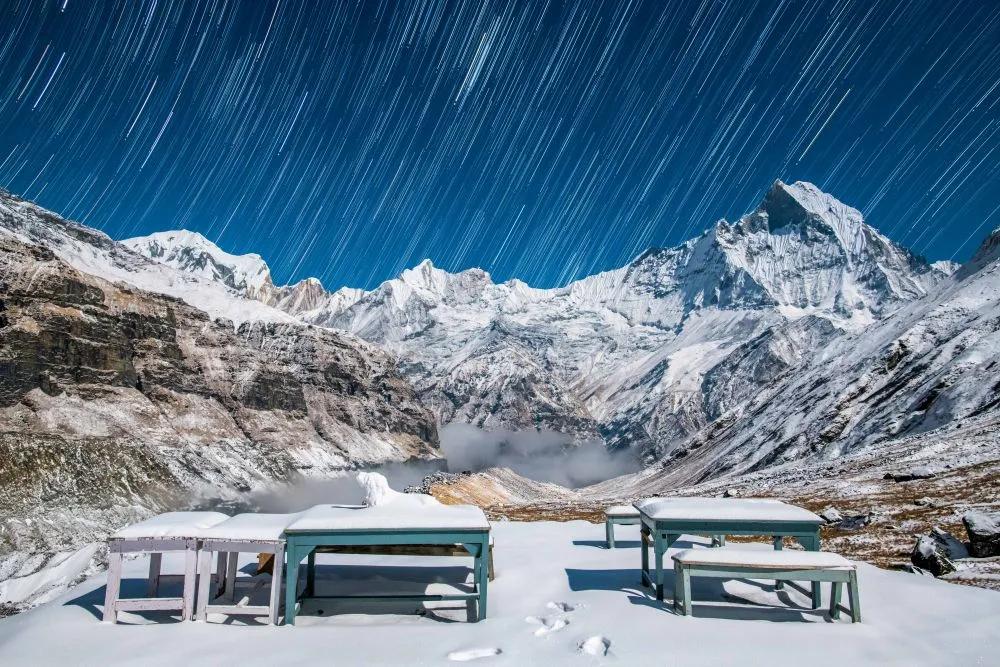One of the pleasant and popular trekking routes of Nepal, the Annapurna Base Camp trek in winter is a journey to paradise. Surrounded by some of the major snow-crowned peaks of the Annapurna Region, this place is heaven on Earth. Despite the fact, Autumn (September – November) and Spring (March – May) are considered the best times for the ABC trek, winter offers its own uniqueness and beauty. Annapurna winter season offers fewer crowds, snow-covered trails, and clear mountain views.
Why Annapurna Base Camp Trek in Winter?
Winter in the Annapurna region completely transforms the view of the landscape. The lush green forest and the green grassy land transform into a white, snowy forest and land. The whole environment looks like a cake garnished with a creamy white texture. The crystal clear skies offer the breathtaking views of Annapurna, Machhapuchhre (Fishtail), Dhaulagiri, and Nilgiri, along with other snow-capped hills which are normally snowless during other seasons.
Highlights of the Annapurna Base Camp trek in Winter:
- Stunning snow-covered trail for snow lovers.
- Peaceful trail as the off-season attracts fewer crowds.
- Crystal clear skies with snow-capped mountain views.
- Golden sunrise above Annapurna I and Machhapuchhre.
- A picturesque time for the photograph enthusiast.
Weather and Temperature in Winter
The Annapurna Base Camp trek in Winter has temperatures during the day remain between 5°C-10°C. But the temperature at the base camp can reach up to -10°C or below at night. Make sure to keep proper layering of clothes, as this time of year in Annapurna Base Camp is extremely cold.
Packing List for Annapurna Base Camp Trek in Winter
A proper Annapurna winter trek relies on proper planning. Low temperatures demand efficient equipment to keep a person warm, dry, and secure.
Clothing
- Best Winter Camping Base Layer – Thermal or moisture-wicking merino wool base layer to manage body temperature.
- Insulating Layer – Fleece or down mid-layer for warmth.
- Outer Layer – Waterproof and windproof parkas and trousers to protect against snow and wind.
- Annapurna Winter Jackets – A Minimum 700-fill power down jacket is recommended for extreme cold.
Footwear & Accessories
- Waterproof trekking boots with adequate traction (strictly on icy trails)
- Thermal socks (carry extra pairs)
- Warm hat and neck gaiter
- Sunglasses (snow glare is blinding)
- Gloves – inner liner and insulated outer gloves
Other Winter Trekking Gear
- Trekking poles for added support on snow and ice
- Sleeping bag with a rating of at least -15°C
- Microspikes or crampons for slippery trails
Accommodation & Food during Winter
It’s highly recommended to contact the tea houses in advance during the Annapurna Base Camp trek in winter season. As during the off-season, the majority of tea houses are closed because of are fewer crowds trekking in this season. Expect warm food like Dal Bhat, soups, and noodles, and cozy dining rooms with a central woodstove to keep you warm.
Troubles of Winter Trek to Annapurna Base Camp
While the Annapurna Base Camp in winter is stunningly beautiful, it does pose some difficulties that one will have to be ready for:
- The snow and ice on the trail make the terrain slippery, particularly from Deurali to Machhapuchhre Base Camp to ABC, so the employment of trekking poles or microspikes is highly recommended.
- Short daylight hours during the Annapurna winter season require early starts and an early arrival at camp to prevent walking in the dark for safety.
- Early mornings and cold nights can reach as low as -10°C or worse at base camp, and so a down jacket, insulated sleeping bag, and optimum base layer for winter camping are an absolute necessity.
- There may be a requirement for the occasional deviation in routes if trail signs are covered with deep snow or if some routes are rendered unsafe, and flexibility in itineraries is important to ensure safety on an Annapurna winter ascent.
With adequate ABC winter trekking gear, physical fitness, and adaptability, all these challenges can be overcome and even form part of the thrill in reaching the snowy ABC winter haven.
Final Thoughts
The Annapurna Base Camp Trek In winter is a special blend of remoteness, stunning white scenery, and unobstructed mountain views. It’s the perfect trek for explorers looking for a less-populated trek and who are prepared for fewer crowds and lower temperatures. With good planning, enough equipment, and an open mind, winter turns this congested trek into an exotic Himalayan experience.
FAQs
Can you do Annapurna Base Camp in December?
Yes, you can do the Annapurna Base Camp trek in December, but it is more chill compared to other seasons.
What is the best time for Annapurna Base Camp?
Autumn (September – November) and Spring (March – May) are considered the best times for the Annapurna Base Camp trek
How difficult is ABC Trek?
The ABC trek is moderate in difficulty.
Why trek ABC in winter?
Although the winter trek is not highly recommended due to extreme cold, it offers stunning mountain and landscape views with a snow-covered trail.
